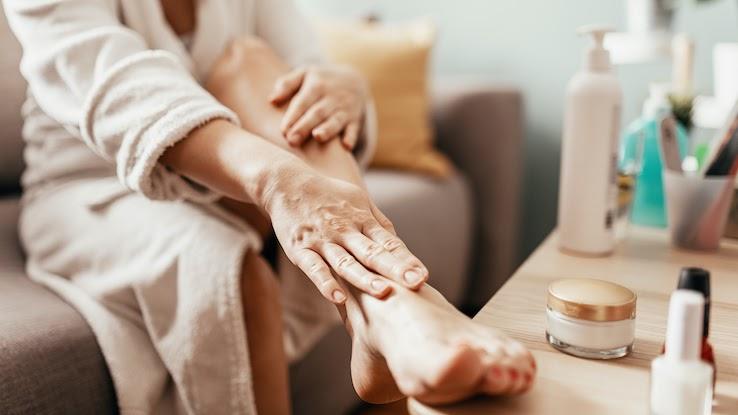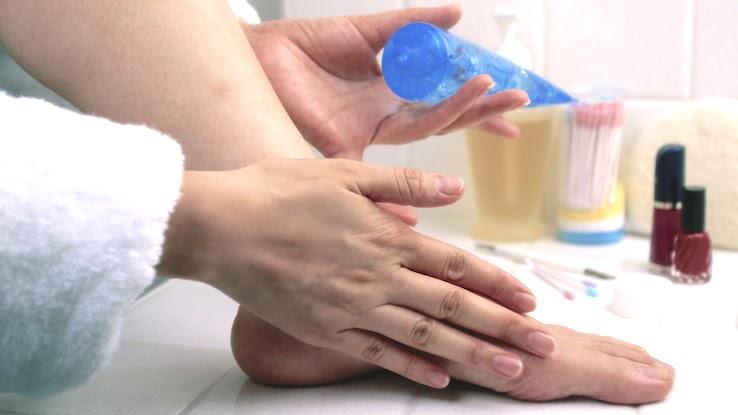Dry Cracking Nipples During Breast Feeding

Many things you do in your daily life can take a toll on your feet, leading to wear and tear over time that can get downright uncomfortable. Often, this comes in the form of dry skin and cracks, called fissures, on the bottoms of your heels. If you leave this skin breakdown alone and don't take care of it thoroughly, it can turn into a much bigger problem. If you find your feet regularly feeling rough and scaly, learn more about common causes of dry, cracked feet, and ways to address this issue.
When your skin appears and feels dry, this means its cells are dehydrated or don't contain enough water. This can happen if you're not staying properly hydrated by drinking enough fluids. Cold climates with low humidity levels can also dry out your skin, as can long, hot showers without adequate moisturization afterward. Take note of whether you moisturize your feet as often as you do the rest of your body, particularly after you bathe.

In addition, normal daily activities can further dry out the skin on your feet. Repetitive-motion activities like walking or hiking can lead to patches of dry, thickened skin called calluses on your heels or soles. Then, the added pressure and friction of walking can spread this thickened skin and lead to itching and cracks. These other activities can also lead to cracking:
- Standing: Standing for long periods increases pressure on the skin of your feet, especially in bony areas.
- Getting Feet Wet: If your feet tend to stay wet for long periods of time, either from hanging out by the pool or getting caught in the rain, this can cause the skin to weaken if you don't use a product to seal in moisture afterward.
- Wearing Uncomfortable Shoes: Shoes that are slightly too small or too big can rub against your skin, causing blisters or worsening cracks in dry skin.
Additionally, certain health conditions can cause dry, cracked skin. These include:
- Hypothyroidism
- Vitamin deficiencies
- Psoriasis
- Diabetes
- Dermatitis
- Fungal infection
Why Dry And Cracked Feet Can Be Dangerous
Once the skin on your feet becomes severely dry, it can begin to form cracks. These cracks can bleed and become painful as they get bigger and deeper over time. Without an adequate skin barrier, these cracks are also entry points for germs, meaning that your risk of developing an infection increases. This can be especially dangerous for individuals with diabetes or suppressed immune systems because it can be harder for their bodies to fight off an infection.

People with diabetes are also prone to developing nerve damage in their feet, which can become an issue because they may not be able to feel blisters, sores, cracks or other wounds that develop. Diabetics should pay close attention to taking good care of their feet to avoid potential consequences of infections.
Remedies to Soften Your Feet
If your feet are starting to feel or look dry, it's not too late to reverse the damage. Adding these simple steps to your daily routine can help soften the skin on your feet and prevent cracking:

- Increase your water intake to prevent dehydration.
- Use gentle skin cleansers and avoid products that contain alcohol or added fragrances that can further dry out your skin.
- Use a foot scrubber or exfoliating product to remove the outer layer of dry skin.
- Moisturize your feet at least twice a day. Remember that moisturizer works to lock in hydration, so wet your feet before applying the moisturizer.
- Try moisturizers that contain salicylic acid or alpha hydroxy acid. These ingredients help to remove dry skin flakes. Be aware that these ingredients can also cause some stinging or irritation.
- Soak your feet. Use room temperature or warm water and soak your feet for about 10 minutes before patting them dry and applying moisturizer.
- Apply petroleum jelly or coconut oil and put on socks after soaking your feet to seal in the added moisture.
Once your feet are back to baby smooth, you can use these tips to ensure that they continue looking and feeling good:
- Check your feet frequently for sores, cuts and blisters.
- Check your shoes for any debris before putting them on.
- Always apply sunscreen on the tops of your feet when they're exposed to the sun.
- If you have diabetes or another health condition that predisposes you to dry skin, consider visiting a foot doctor (podiatrist) on a regular basis to get your feet assessed for signs of infection and other risks.
It's easy to neglect your feet when there are so many other health habits to pay attention to. But it's important to take proper care of your feet so they can take you where you want to go. If these simple home remedies aren't leading to improvements in your dry, cracked feet over time, or if the cracks are accompanied by redness or a rash, consult with a healthcare professional to figure out and start treating the underlying causes.
Resource Links:
https://www.mayoclinic.org/diseases-conditions/dry-skin/expert-answers/cracked-heels-treatment/faq-20455140
https://www.mayoclinic.org/diseases-conditions/hypothyroidism/symptoms-causes/syc-20350284
https://www.ncbi.nlm.nih.gov/pmc/articles/PMC5297015/
https://medlineplus.gov/ency/patientinstructions/000751.htm
https://www.mdpi.com/1422-0067/19/1/70/htm
powerfroplithe1943.blogspot.com
Source: https://www.thehealthfeed.com/healthy-living/prevent-dry-cracked-feet?utm_content=params%3Ao%3D1668962%26ad%3DdirN%26qo%3DserpIndex&ueid=043a0d67-8884-43d5-a2c0-c53087d586d7